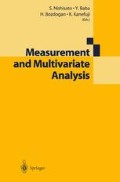Summary
This paper is prepared to serve the purpose of introducing the readers to the main theme of this conference. The emphasis is placed on the introduction of desirable properties of measurements so as to make the outcomes of multivariate analysis meaningful. Starting with such fundamental requirements for measurements to be valid as metric axioms and the Young-Householder theorem, the paper is then extended to the discussion of two topics where we see important interplays between measurement and multivariate analysis. The paper is concluded with a note on the importance of a well-balanced interplay between measurement and multivariate analysis, to which end this international and interdisciplinary conference was planned and successfully organized.
Access this chapter
Tax calculation will be finalised at checkout
Purchases are for personal use only
Preview
Unable to display preview. Download preview PDF.
References
Beltrami, E. (1873). Sulle funzioni bilineari [On the bilinear releations[. in G. Battagline and E. Pergola (Eds.) Giornale di hfathematiche, 11, 98–106.
Bentler, P.M. (1989). EQS structural equation program manual. Los Angeles: BMDP Statistical Software.
Bock, R. D. (1960). Methods and applications of optimal scaling. The University of North Carolina Psychometric Laboratory Research Memorandum, No. 5.
Bollen, K.A. (1989). Structural equations with latent variables. New York: Wiley Interscience.
Bollen. K. and Long, S. (eds.) (1993) Testing structural equation models. Newbury Park: Sage.
Cronbach, L.J. (1951). Coefficient alpha and the internal structure of tests. Psychometrika, 16, 297–334.
de Leeuw, J. (1973). Canonical analysis of relational data. Department of Data Theory, Leiden University, Report RN 007–68.
Eckart, C. and Young, G. (1936). The approximation of one matrix by another of lower rank. Psychometrika, 1, 211–218.
Escofier-Cordier, E. (1969). L’analyse factorielle des correspondances. Bureau Universitaire de Recherche Operationelle, Cahiers, Série Recherche, 13, 25–29.
Gabriel, K.R. (1971). The biplot graphical display of matrices with applications to principal component analysis. Biometrika, 58, 453–457.
Gorsuch, R.L. (1983). Factor analysis ( second edition ). Hillsdale, N.J.: Lawrence Erlbaum.
Hamming, R.`V. (1950). error detecting and error correcting codes. The Bell Sys-tern Technical Journal, 26, 147–160.
Hayashi, C. (1950). On the quantification of qualitative data from the mathematicostatistical point of view. Annals of the Institute of Statistical Mathematics, 2, 35–47.
Hand, D. J. (1996). Statistics and the theory of measurement. Journal of the Royal Statistical Society, A, 150, Part 3, 445–492.
Hemsworth, D. (2002). The use of dual scaling for the production of correlation matrices for use in structural equation modeling. Unpublished Ph.D. thesis, University of Toronto.
Hill, M.O. (1974). Correspondence analysis: A neglected multivariate method. Applied Statistics, 23, 340–354.
Hirschfeld, H.O. (1935). A connection between correlation and contingency. Cambridge Philosophical Society Proceedings, 31, 520–524.
Horst, P. (1935). Measuring complex attitudes. Journal of Social Psychology, 6, 369–374.
Hotelling, H. (1936). Relation between two sets of variables. Biometrika, 28, 321–377.
Jordan, C. (1874). Mémoire sur les formes bilinieares [Note on bilinear forms]. Journal de Mathématiques Pures et Appliquées, Deuxiéme Série, 19, 35–54.
J6reskog, K. and Sorbom, D. (1981). Analysis of linear structural relationships by maximum likelihood and least squares methods. ( 81–8 ). Uppsala: University of Uppsala.
Kendall, M.G. and Stuart, A. (1961). The advanced theory of statistics. Volume II. Longon: Griffin.
Minkowski, H. (1896). Geometrie der Zahlen. Leipzig: Teubner.
Muthén, B. 0. (1987). LISCOMP: Analysis of linear structure equations with a comprehensive measurement model. Moorresville, Indiana: Scientific Software.
Nishisato, S. (1980). Analysis of categorical data. Toronto: University of Toronto Press.
Nishisato, S. (1993). On quantifying different types of categorical data. Psychometrika. 58, 617–629.
Nishisato, S. (1994). Elements of dual scaling. Hillsdale, N.J.: Lawrence Erlbaum.
Nishisato, S. (1996). Gleaning in the field of dual scaling. Psychometrika, 61, 559–599.
Nishisato, S. (1998). Unifying a spectrum of data types under a comprehensive framework for data analysis. A talk presented at a symposium at the Institute of Statistical Mathematics, Tokyo, Japan.
Nishisato, S. (2000). Data types and information: Beyond the current practice of data analysis. In Decker, R., and Gaul, W. (eds.), Classification and Information Processing at the Turn of the Millennium. Heidelberg: Springer-Verlag, 40–51.
Nishisato, S., and Arri, P. S. (1976). Nonlinear programming approach to optimal scaling of partially ordered categories. Psychometrika, 40, 525–548.
Nishisato, S. and Hemsworth, D. (2001, in press). Quantification of ordinal variables: A critical inquiry into polychoric and canonical correlation. To appear in Baba. Y. et al. (eds.), Recent Advances in Statistical Research and Data Analysis. Tokyo: Springer-Verlag.
Nishisato, S. and Sheu, W. J. (1980). Piecewise method of reciprocal averages for dual scaling of multiple-choice data. Psychometrika, 45, 467–478.
Pearson, K. (1901). On lines and planes of closest fit to systems of points in space. Philosophical Magazine and Journal of Science, Series 6, 2, 559–572.
Pierce, J.R. (1961). Symbols, signals and noise: The nature and process of communication. New York Harper and Row.
Richardson, M. and Kuder, G.F. (1933). Making a rating scale that measures. Personnel Journal, 12, 36–40.
Schmidt, E. (1907). Zür Teheorie der linearen and nichtlinearen Integralgleichungen. Erster Teil. Entwicklung willk-“urlicher Funktionen nach Systemen vorgeschriebener [On theory of linear and nonlinear integral equations. Part one. Development of arbitrary functions according to prescribed systems]. Mathematische Annalen, 63, 433–476.
Stevens, S. S. (1951). Mathematics, measurement, and psychophysics. In Stevens, S.S. (ed.), Handbook of experimental psychology. Wiley, Chapter 1, 1–19.
Tallis, G. (1962). The maximum likelihood estimation of correlation from contingency tables. Biometrics, 18, 342–353.
Torgerson, W.S. (1952). Multidimensional scaling. I. Theory and method. Psychometrika, 17, 401–419.
Torgerson, W. S. (1958). Theory and methods of scaling. New York: Wiley.
Yanai, H., Shigemasu, K., Maekawa, S. and Ichikawa, M. (1990). Inshi bunseki (Factor analysis. Tokyo: Asakura Shoten (in Japanese).
Young, G. and Householder, A.S. (1938). A note on multi-dimensional psychophysical analysis. Psychometrika, 6, 331–333.
Author information
Authors and Affiliations
Editor information
Editors and Affiliations
Rights and permissions
Copyright information
© 2002 Springer Japan
About this paper
Cite this paper
Nishisato, S. (2002). Measurement and Multivariate Analysis. In: Nishisato, S., Baba, Y., Bozdogan, H., Kanefuji, K. (eds) Measurement and Multivariate Analysis. Springer, Tokyo. https://doi.org/10.1007/978-4-431-65955-6_3
Download citation
DOI: https://doi.org/10.1007/978-4-431-65955-6_3
Publisher Name: Springer, Tokyo
Print ISBN: 978-4-431-65957-0
Online ISBN: 978-4-431-65955-6
eBook Packages: Springer Book Archive

